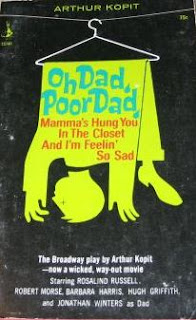
Directing Lemmon and Novak in "Landlady"

Quine at workRichard Quine never settled. Even as a house director at Columbia, where he was largely assigned work during the 1950s, he summoned an uneasy, idiosyncratic personal touch that made him a closeted auteur. Back then, he came in under the radar and, in some cinema circles, still does.
But he's a favorite of this site, not only because he coaxed the best, least mannered screen work out of Jack Lemmon (sorry, Messrs Wilder and Edwards), but precisely because his style was so uneasy and idiosyncratic - apparently, much like the complex, troubled man himself.
Lately, much has been written about Quine's work at Columbia. His name is invoked regularly on Dave Kehr's essential site, and he was the subject of "Richard Quine at Columbia," a mini-retrospective presented by the film arm of the Los Angeles County Museum of Art in August of 2008.
His three main connections at Columbia were Lemmon (whose screen test was directed by Quine), studio head Harry Cohn (who put Quine under contract following Quine's years as an actor there) and Kim Novak (entrusted to Quine by Cohn to groom into an actress and a star).
Novak was Quine's muse-cum-fiancée, and when they made 1960's "Strangers When We Meet," a superior soap opera whose plot revolves around a swank Malibu home being designed for a writer, Columbia displayed its respect for Quine - and also support for his relationship with Novak - by building a real house for the film, which was to be given to them after shooting as a wedding present. But the couple part ways during the shoot and much of the anxiety in Novak's performance (her best) could directly stem from the real-life break-up.
Quine made his directing debut in tandem with William Asher on 1948's "Leather Gloves," whose cast included a young actor named ... Blake Edwards, and many of his Columbia films were made in collaboration with Edwards. Quine and Edwards, for example, wrote the script for the 1955 musical remake of "My Sister Eileen." (Perhaps not coincidentally, Quine had an acting role in Columbia's original 1942 version of "My Eileen Sister," playing along side Rosalind Russell.)
Working outside the axis of the Columbia lot on North Gower, Quine's work took on a different dimension. Early on, he did the Tony Curtis-Gene Nelson musical, "So This Is Paris" (1955) for Universal, but his extracurricular professional life really started in earnest in 1960 when he directed William Holden and Nancy Kawn in the film version of the Paul Osborn play, "The World of Suzie Wong" for Ray Stark and Paramount.
After directing Lemmon and Novak in "The Notorious Landlady" in 1962, Quine dove into three back-to-back comedies - "Paris - When It Sizzles" (1964), "Sex and the Single Girl" (1964) and "How to Murder Your Wife" (1965), for Paramount, Warner Bros. and United Artists, respectfully.
He returned to Columbia in '65 to direct Stella Stevens in the addiction drama, "Synanon," done verité-style; segued into Warners' "Hotel" in '67 and, the same year, had a reunion with Roz Russell directing her in his hugely idiosyncratic version of the Arthur Kopit play, "Oh Dad, Poor Dad, Mama's Hung You in the Closet and I'm Feeling So Sad," for Paramount.

In 1969-1970, he did two solid Richard Widmark films - "A Talent for Loving" for Paramount" and "The Moonshine War" for MGM - neither getting much of a studio push. Quine's last two films, both disposable Peter Sellers vehicles, were Universal's "The Prisoner Zenda" (1979) and Warners' "The Fiendish Plot of Dr. Fu Manchu" (1980), which he started but never completed. Piers Haggard receives credit for "Fu Manchu."
Nine years later, Richard Quine would commit suicide by shooting himself, tired of waiting for offers to direct the kinds of films he wanted to make. Perhaps the kind he made his original home base, Columbia.
Quine did his best work there. He may have been that rare filmmaker who worked best as a hired hand, a contract director.
The standout among his final films is an unsung gem that is reminiscent of his "Pushover"/"Drive a Crooked Road" days working for Cohn. "W," a tidy thriller that Quine made in 1974 for Cinerama Releasing, fell through the cracks the minute it was released. It was barely noticed.
As he did with Kim Novak 20 years earlier, Quine nudged a credible, often appealing performance from Twiggy, cast as a woman hounded by a serial killer whose sole clue is the letter W left at the scene of each crime. It was her second film, following Ken Russell's "The Boy Friend" in 1971, and her sincerity at trying to give a valid performance is palpable.
I can't recall another performer who tried so hard to be so good - and much of Twiggy's drive here, I surmise, comes from having Richard Quine - and, yes, his uneasy, idiosyncratic touch - behind her.
BTW, "W" is available on DVD - but not as "W." It's been retitled for the occasion ... "I Want Her Dead." Yeesh.
Note in Passing: Richard Quine, the young actor, can be seen as Howard in S. Sylvan Simon's incredibly charming "The Cockeyed Miracle" (1946), in which he romantically pursues Audrey Totter. It airs on Turner Classic Movies at 6:30 a.m. (est.) on 20 January; it's Audrey Totter day on Turner. Frank Morgan, Keenan Wynn, Cecil Kellaway, Gladys Cooper and a very young Marshall Thompson round out Simon's game, happy cast.
No comments:
Post a Comment